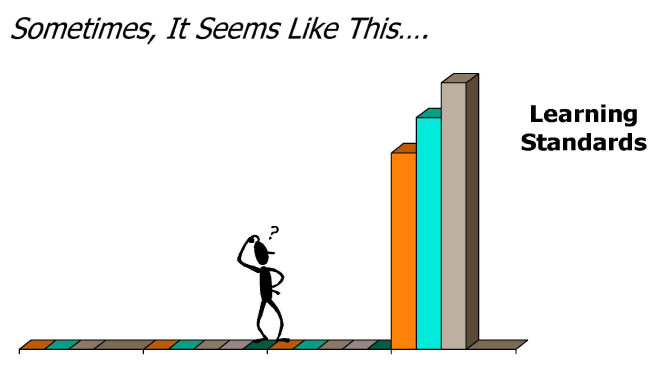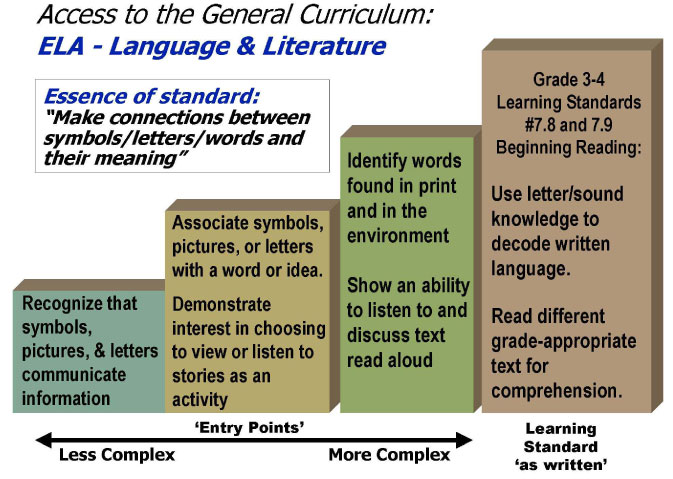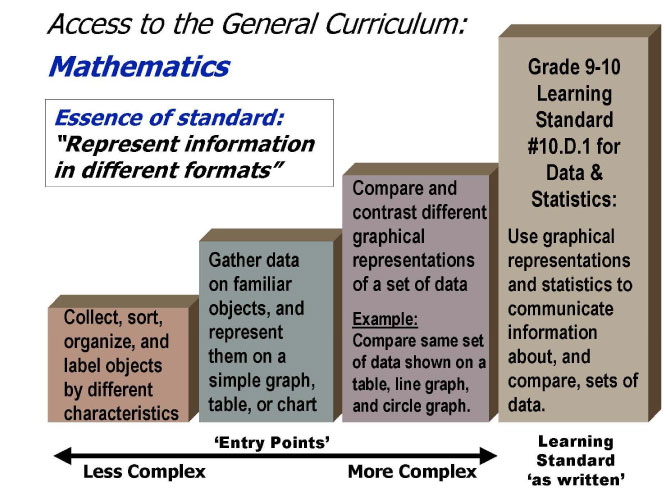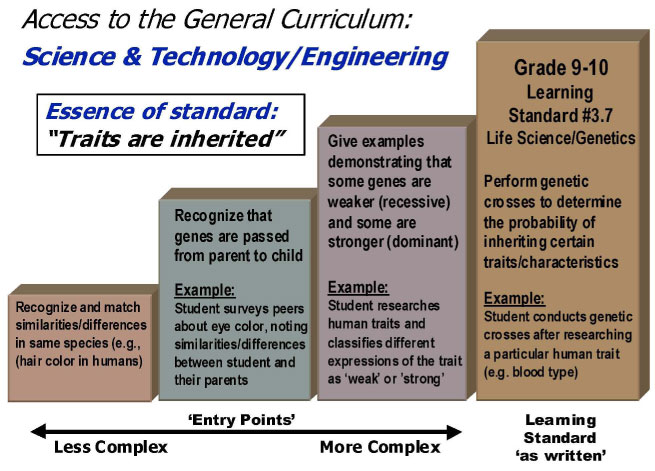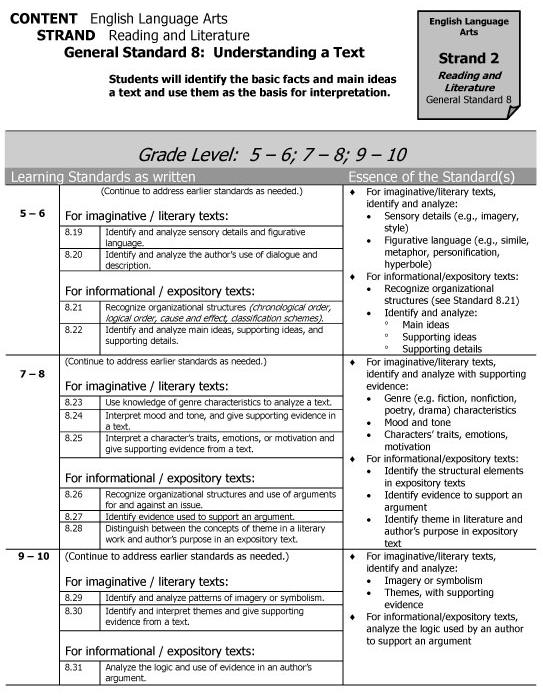
One State's Story: Access and Alignment to the GRADE-LEVEL Content for Students with Significant Cognitive Disabilities
NCEO Synthesis Report 57
Published by the National Center on Educational Outcomes
Dan Wiener
Massachusetts Department of Education
December 2005
Wiener, D. (2005). One state's story: Access and alignment to the GRADE-LEVEL content for students with significant cognitive disabilities (Synthesis Report 57). Minneapolis, MN: University of Minnesota, National Center on Educational Outcomes. Retrieved [today's date], from the World Wide Web: http://cehd.umn.edu/NCEO/OnlinePubs/Synthesis57.html
EDITOR’S NOTE: In December, 2004, the National Center on Educational Outcomes (NCEO) hosted one of its series of national telephone conferences on the topic of access and alignment to the grade-level content for students with significant cognitive disabilities. Dan Wiener from the Massachusetts Department of Education was our practitioner presenter, along with researchers from the University of Kentucky and the University of North Carolina, Charlotte. Dan Wiener’s presentation was a powerful case study of why and how one state ensures that ALL children have access to the grade level curriculum, and achieve at high levels. This publication is in response to many requests for his story.
Overview
If we think about what we want education to be like for our students with significant cognitive disabilities, we would have to say, at the very least, that we want school to be an engaging experience, and that we should be teaching them as much as we can in the precious time we have, taking students as high and as far as possible, stretching them, enriching them, and helping them explore their own capacities and explore the world around them to the greatest extent possible. In fact, this sounds a lot like what we want for all our students.
The notion of providing opportunities to learn the same interesting ideas and stimulating experiences to students who have significant cognitive disabilities as we do for non-disabled students does not seem like such a radical idea after all. But it only works if we provide these opportunities at a level that challenges each student and allows him or her to enjoy some success at what he or she is attempting to accomplish. And it makes sense only if we know where we are going, where we want to take the student once he or she masters what we are teaching him or her. We must know where we want to be when their education is complete which, in the experience of Massachusetts, is to get as close as possible to the grade-level standards that typical students are learning. We feel that is a good goal for us to have, and an important statement to make about the goal of special education.
Think what the results might be if we equipped our special educators with the same content knowledge that general educators have, so they could put their considerable skills to work adapting and modifying that curriculum, because we know that is what special educators already do well. We would really be onto something big! We have tried to do that in Massachusetts. We have provided those special educators who work with students who are the most difficult to include in the curriculum with a roadmap to make it possible for them to grasp, at a conceptual level, what is expected of all students (the standards), and to understand the process for customizing that curriculum for each student. Then, we have shown them how to collect data and to document a student’s progress learning targeted skills in the student’s portfolio that gets used in the school, and later submitted to the state as an alternate assessment.
One State’s Case Study
At first, our special educators struggled with the idea of addressing academic standards with their students with more significant cognitive disabilities. First of all, in most cases, these teachers were working with students who were a long way from achieving the same outcomes as other students. Second, these educators felt that their students were simply not visible in the expression of the outcomes described for all students. There was a tendency to feel that their students with significant cognitive disabilities were neglected in the process of developing high standards and performance benchmarks. Third, expectations of what their students could achieve, in many cases, was limited to fairly low-level daily living skills. As we prepared schools for what would be coming (that is, a required statewide alternate assessment on students’ academic learning), internally we knew we had some work to do in order to make students with significant cognitive disabilities visible in the state’s learning standards. We did that both by “expanding” those performance outcomes so they could be addressed by this population; and by describing and defining the important features of each standard that special educators would need to know before they could put them into effect in their classrooms. From this process, which was continued over about a year-and-a-half, we produced what we called the Resource Guide to the Massachusetts Curriculum Frameworks for Students with Significant Disabilities (or simply the “Resource Guide”). An excerpt from the Resource Guide is provided in Appendix A.
It is helpful to understand the process we used to identify the “essence” of each standard, and to develop “entry points” at increasing levels of complexity, based on a general understanding of the essence of that standard. The process tool we used is shown in Appendix B. In order to create our resource guide to the standards, we invited experts to serve on panels representing each of four content areas. These experts included: content area specialists, assessment experts, special educators familiar with this population, higher education faculty, parents and advocates, and members of our contractor team from Measured Progress, ILSSA at the University of Kentucky, and the Institute for Community Inclusion at the University of Massachusetts. I emphasize the importance of content area experts in this process, since they know the critical skills and concepts that must be taught. Assessment experts are also crucial to this process, since they can determine how and whether an outcome can be assessed reliably. This process cannot be accomplished by special education staff alone, but through the combined efforts of those who understand the content, understand the students, and understand the assessment process.
Led by our contractors, each panel reviewed the standards in each content area, and discussed the big ideas contained in each standard. What was each standard saying students should understand and be able to demonstrate? What curriculum content was covered, what skills and concepts were being taught? We reflected on the intent and meaning of each standard, and on the big ideas and key skills and content that it described; then we created a statement of the “essence” of each standard in common terms, using bulleted lists to assist those who were not specifically trained in the content area. For example, a grade 6 Math standard that says: “Students will use various graphic representations of data to make inferences and estimates about a situation” might state in its essence that “students draw conclusions from observations and information presented in a variety of different graphic formats.”
After the panelists understood and agreed on the essence of each standard, they determined the lowest level of complexity at which that standard could be addressed while maintaining its essence; in effect, “how low could you go?” for each standard. That became the lowest level of complexity at which that grade-level standard could be addressed.
The panel added two more outcomes at successively higher levels of complexity so teachers and students would continue to move their students through a progression of skills, approaching the standard as it was written for all students at that grade level. Each of these “entry points” serves as a building block, or a step up the staircase, leading to the standard as written for all students. When we train our teachers, we direct them to begin with the standard as written for a student in that grade, and work downward in complexity from the top, rather than up from the bottom. This helps teachers understand first what other students are learning so they can determine a challenging and attainable level of complexity at which to teach a student the grade-level standard. We also instruct teachers to start with the standards, then design classroom activities to meet them, rather than “mapping” existing activities to the standards as an afterthought.
Our panels described these “entry points” (or outcomes) in academic, rather than functional, terms. For example, students are learning to count by 2’s and 5’s, to sort objects by their attributes, use beads and cubes to create and recognize patterns, as well as learning about money and time; they learn about heat transfer, magnetism, and photosynthesis, all at a level of complexity that challenges each individual student, and allows the student to make progress learning these skills with as much accuracy and independence as possible.
We begin to see how academic activities have intrinsic value as students become accustomed to participating in them. We as educators learn more about what students enjoy and, importantly, how they communicate, whether through eye-gaze, nodding their head, or squeezing their hand. The important lesson in all of this is that these students have surprised and amazed us with what they are capable of learning. We have now heard this from hundreds of teachers. “I didn’t know my student could do this.” “I never knew she understood what I was teaching her.” Because assessment for these students is important and required by law, we have all had to work extremely hard to find the best, most flexible way for these students to demonstrate and express what they have learned. Evidence is unquestionable when it is before you in a portfolio or on a data sheet as you review a child’s progress with a parent and other members of the IEP Team.
We have found it helpful to demonstrate how students might access the standards in different ways and at differing levels of complexity. Appendix C includes several examples of how we work with teachers and parents to show them how all students can access the grade level content.
We acknowledge, though, that there is a very small percentage of students functioning at the very lowest levels of cognition and environmental awareness who may not be ready, as yet, to address curriculum content, but who nevertheless could benefit from exposure to the routines and materials in math, science, and social studies. These students must also participate and make progress in the general curriculum, though they start at a much lower point than other students within the so-called “1%.” These lowest-functioning students should all be present during academic instruction, though they may at first be working on more basic “access” skills during these standards-based activities, and may simply enjoy participating in stimulating activities as they become familiar with new ideas and materials. There is every reason to believe, for example, that a student who is just becoming aware of his or her surroundings and is learning to communicate can derive great pleasure from being part of an activity building a mobile of the solar system, or populating a diorama built by other students with bright colorful examples of sea life that light up and move at the touch of a switch. At this point, we have set the table for these students to explore the world of academic ideas and begin engaging in actual curriculum content. This is a dynamic process that begins at the point of engagement, and truly has no end, which may be a new way of looking at all our jobs as special educators.
In training teachers to use the Resource Guide to access the learning standards, and also to conduct alternate assessments, we have acknowledged that we have required teachers to do more work and made teachers more visible and accountable in the process. Teachers are made aware of the standards addressed by typical students, then asked to individualize those standards for their students. We ask them to become effective data-collectors, and to learn to compile a student portfolio. They put forth tremendous effort, and we are proud of Massachusetts teachers for their courage and faith in the system. At first, that is what many proceeded on: FAITH. Many did not have a sense that this was a good fit for their students, but they rose to this challenge and did the alternate assessments, as they were required. In the process of accepting this new responsibility, they succeeded over time in transforming our expectations that all students can indeed participate in the curriculum, make progress, and enjoy success.
Teachers responded at first with many philosophical questions, like “why is math so important for these students anyway?” And “why should I put so much effort into the alternate assessment when these students won’t meet the state’s graduation requirement?” These were good questions that required thoughtful answers, about the value of enriching the lives of students with disabilities, and speaking the same cultural language as their peers, and how special education is about so much more than learning to dress oneself and behave appropriately. These skills are of course important, but they are not to be the focus of alternate assessments, unless all students are also measured on such skills.
Logistical and tactical questions followed after that: “I can’t possibly fit all this extra work into my already-hectic school day” and “there’s no time for this—I have to teach my functional curriculum.” Over time, these questions gave way to more mundane, mechanical questions, like: “How do I set up my data chart?” and “what kinds of products are allowed in the portfolio?” There are very few debates these days about the philosophy and benefits of the alternate assessment. What began with difficult and often contentious meetings with teachers and school administrators, over time has led to an understanding that this is serious business; it is important; it is not going away; and we at the Massachusetts Department of Education are equipped to train and assist, if you ask for help.
Because we continue to invest so heavily in training our teachers, and using their expertise to train their colleagues and to score student portfolios each summer, these teachers have gained a sense of themselves as true and valued professionals. As one teacher said to me, “I used to be shy before I started doing alternate assessments. Now I get everything I need.” They have become even better advocates for themselves and the needs of their students.
We convene a network of hundreds of our most expert teachers on a regular basis to advise us on policy and planning, to try out new ideas, and to check in and see what is working and what is not. In fact, including different subject constituencies in the development process, ongoing state advisory committees, and creating a network of expert teachers has been a major reason for the success we have experienced.
There are subtleties and details that, for lack of space, cannot be discussed here, but can be found in other publications in order to learn more about the process Massachusetts has gone through. The NCEO publication, Massachusetts: One State’s Approach to Setting Performance Levels on the Alternate Assessment, discusses the process we used and the questions we addressed in detail as we developed the MCAS-Alt (see http://cehd.umn.edu/NCEO/OnlinePubs/Synthesis48.html). The Massachusetts Department of Education Web page on alternate assessment at http://www.doe.mass.edu/mcas/alt includes the Resource Guide (to the Frameworks), the Educator’s Manual for MCAS-Alt, the Statewide Report on the MCAS Alternate Assessment, and other related publications, which together provide ideas and perspectives on where we have taken this initiative and why we made many of the decisions we did.
Conclusion
A key ingredient in our success has been a coordinated message about alternate assessment from a unified state leadership. To accomplish this, much had to be coordinated by whoever was leading this effort in our state, which happened to be me. On many occasions during the first few years of the development process, we brought together the policy-makers and stakeholders to make certain all their concerns were addressed and their questions answered, and that foreseeable consequences had been considered. We made certain that key officials from the assessment office, special education, curriculum and instruction, the Commissioner and other high-level staff, the Legal Office, even the state legislative staff were included in discussions at the beginning and throughout development and early implementation of the alternate assessment. In that way, all of us were ready to respond consistently to questions, challenges, and criticisms that something of this magnitude was likely to generate. We also regularly convened a broad and diverse statewide advisory committee who had lively and stimulating debates that help us make better decisions and prevent differences of opinion from spilling over into more public channels, like the media.
Most of the rough edges have been smoothed, and there has been an effective refitting of much of the special education profession in Massachusetts. The inevitable tinkering and tweaking of the assessment system has occurred when things needed to be fixed, as we expected they would over time, but these changes have occurred slowly over several years. Through all of this, our message has remained virtually unchanged: that all students can learn, and that keeping track of that learning is not only required, but necessary in order to do a good job of educating all students. Now, the “1% rule” has given schools an even greater incentive to educate these students in their local schools, and to take the alternate assessment seriously. We are proud of what we accomplished here, although it has required all our energy and attention.
References
Kleinert, H., & Kearns, J. (2001). Alternate assessment: Measuring outcomes and supports for students with disabilities. Baltimore, MD: Paul H. Brookes
Massachusetts Department of Education. (2001). Resource guide to the Massachusetts curriculum frameworks for students with significant disabilities. Malden, MA: Author.
Massachusetts Department of Education. (2004). 2005 Educator’s manual for MCAS alternate assessment. Malden, MA: Author
Roeber, E. (1999) Creating the link between the curriculum frameworks and all children: Standards alignment proposal for the MCAS-Alt. Dover, NH: Measured Progress.
Wiener, D. (2002). Massachusetts: One state’s approach to setting performance levels on the alternate assessment (Synthesis Report 48). Minneapolis, MN: University of Minnesota, National Center on Educational Outcomes. Available at http://cehd.umn.edu/NCEO/OnlinePubs/Synthesis48.html
Appendix A
Excerpts from: The Resource Guide to the Massachusetts Curriculum Frameworks for Students with Significant Disabilities (Fall 2001) (“The Resource Guide”)

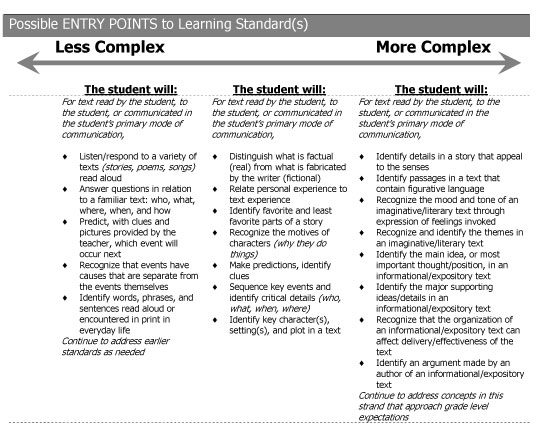
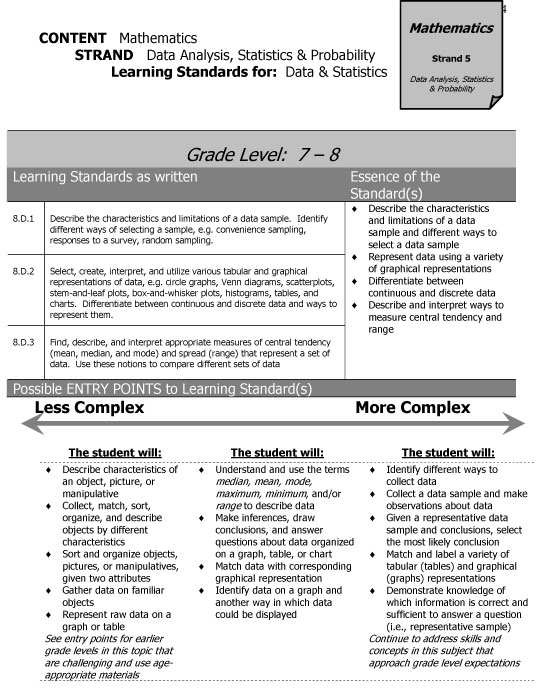
Appendix B
Process Tool for Developing Resource Guide
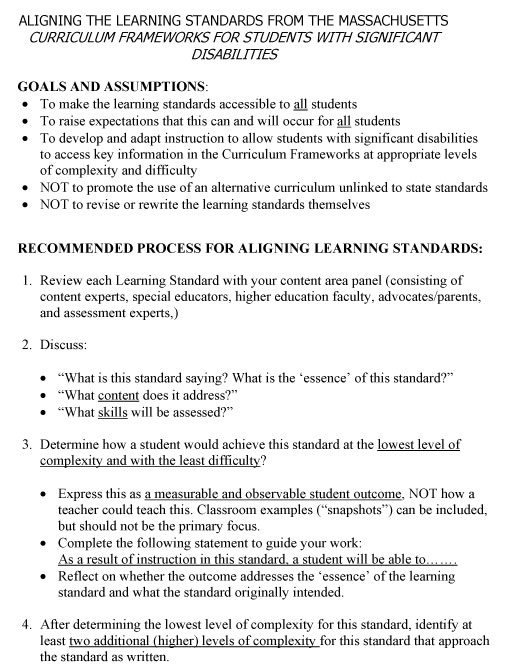
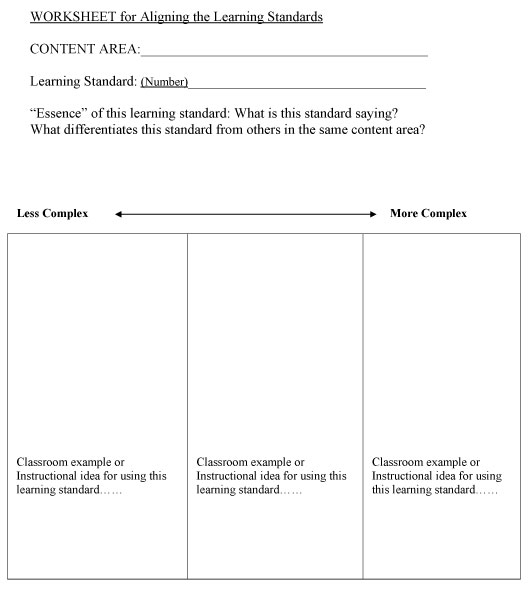
Appendix C
Examples of Resources Used with Teachers, Parents, and the Public to Demonstrate How All Students Can Access the Grade Level Content
